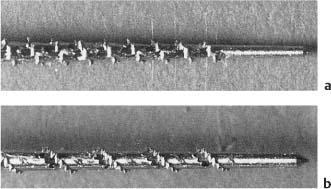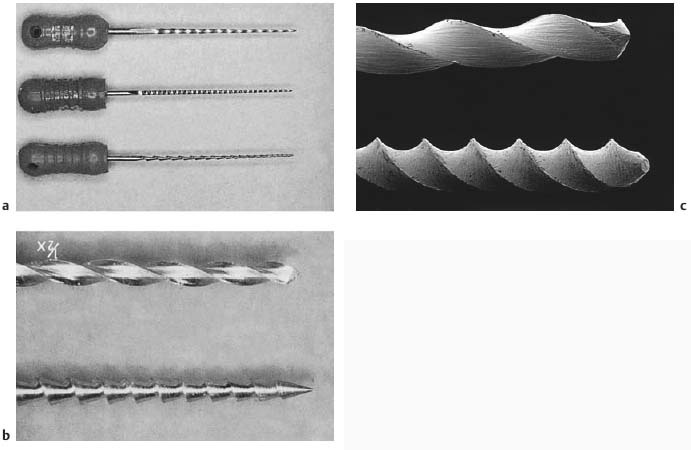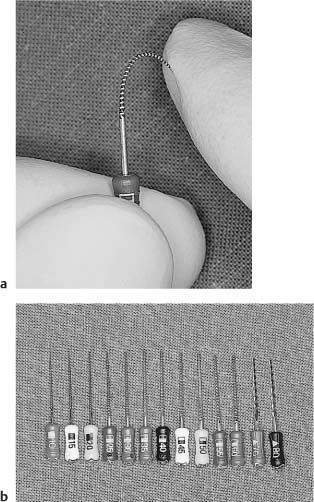9
Endodontic Instruments
A variety of instruments are available for the extirpation of the pulp and the instrumentation, preparation, and obturation of the root canal. Although almost all these instruments were designed between 50 and 100 years ago, important changes have occurred in recent years with regard to their quality, efficacy, and standardization. Root canal instruments are available as hand instruments and many of them as engine-driven instruments.
Root Canal Instrumentation
Hand Instruments
Broaches and rasps. These instruments represent the oldest forms of root canal instruments (Fig. 9.1). They are made from round steel wire blanks and working edges are created by cutting into the wire at an angle to its long axis and then elevating the edges of the cuts. The depth, angle, and number of cuts (barbs) will determine how the instrument is used.
The broach is used to extirpate the vital pulp. It is introduced into the pulp and rotated so that the barbs engage the tissue. The pulp can then be removed, often in one piece. In modern endodontics this method is not recommended, as the pulp tissue is torn somewhere near the apical foramen, often impinging on the periodontal ligament as well. Rather, an instrument is used that cuts the pulp tissue at the desired apical level before it is removed.
The rasps, or “rat tail files,” are used to instrument and enlarge the root canal. Cutting occurs by longitudinal movement of the rasp toward the canal wall. The instrument is effective, but is not widely used today, since the barbs readily fall off during instrumentation and end up in the root canal.
Recently, two instruments with a cutting surface somewhat similar to that of the rasp have been brought onto the market, namely the Rispi file and the Sonic Shaper (Fig. 9.2). These instruments have circumferential grooves rather than single barbs and they hold up in use considerably better than the rasps. At present these instruments are available only with automated devices.
Fig. 9.1 Root canal broaches. A new broach with barbs is visible (top). The barbs have fallen off during use of the broach in the root canal (bottom).
Fig. 9.2
a Rispi file.
b Sonic Shaper file. These instruments have “barb-like” cutting surfaces and smooth ends to avoid ledging of the root canal wall.
Fig. 9.3
a K-reamer, K-file, and Hedstrom file (from top).
b The K-type instruments (top) are twisted to give the working end a spiral form. They are used with longitudinal filing and rotary cutting actions. The flutes of the Hedstrom file (bottom) constitute a continuous, screw-like spiral. The file is used with longitudinal filing actions and is not a rotary cutting instrument.
c Scanning electron micrograph of K-type instruments with sharp, cutting tip (top) and rounded, noncutting tip (bottom).
Reamers and files. Reamers and files are by far the most widely used root canal instruments. Traditionally, this group of instruments has been made from stainless steel and comprises two basic designs, the K-type instruments (K-files and Kreamers) and the Hedstrom file (Fig. 9.3).
The K-type instruments are made from rectangular or triangular blanks. They are twisted to give the working end of the instruments a spiral form. The number of spirals or cutting flutes may differ, but is higher in the file than in the reamer. Another difference is that the file is usually made from a rectangular blank, whereas the reamer has a triangular cross section. Because of its fewer flutes and triangular cross section, the K-reamer is a much more flexible instrument than the K-file. However, triangular K-files with increased flexibility are now available, as are files with a rhomboid-shaped cross section.
The K-file is used to enlarge the canal with a longitudinal filing and a rotational cutting action, or rather by a combination of the two. The reamer may be used in an identical fashion, but is most effective as a rotary cutting instrument. Recently new technology has been developed whereby K-type reamers and files are machined from round wires rather than twisted from square or triangular blanks. This has opened up interesting perspectives in terms of properties like stiffness, sharpness, and flexibility of the instruments. Another modification that has proven to be clinically useful is the rounding off of the original sharp, cutting tip of the K-type instruments (Fig. 9.3). Instruments with an inactive noncutting tip follow the root canal better than instruments with active tips. Still, stainless steel instruments are rigid enough that they should be precurved to match the curvature of the root during instrumentation of curved canals.
The versatility of the K-type instruments was further greatly improved by the introduction of instruments made of nickel-titanium. This material is superelastic and instruments made of nickel-titanium are extremely flexible (Fig. 9.4). With a noncutting tip they will follow curved canals well. The instrumented canals will be well centered and inner-curve strip perforations and apical outercurve “elbows” or perforations that might occur with the more rigid steel instruments are basically not seen. Thus, in curved canals the nickel-titanium instruments offer real advantages because of their flexibility.
Fig. 9.4
a A nickel-titanium instrument is bent to show its flexibility.
b Practical sequence of K-type instruments. The size 10, 15, and 20 instruments are in stainless steel. The instruments size 25–60 are in nickel-titanium, and from 70 and up again in steel.
The nickel-titanium files are machined from round wires since, because of the flexibility of the material, they cannot be twisted. K-files are made in sizes 10–60. They are not nearly as sharp and effective as matching instruments made of stainless steel. Still, because of their extreme flexibility they will often be the instruments of choice. However, the smallest nickel-titanium instruments (sizes 10–20) are so flexible that they become ineffective and very difficult to use. It is therefore good clinical practice to use steel files in the smallest sizes since they are flexible enough and then to begin the nickel-titanium instruments with size 25 (Fig. 9.4).
The Hedstrom file is made from a round blank. The flutes of the file are machined into the blank and constitute a continuous spiral like in a screw (Fig. 9.3). The angle of the flutes to the long axis of the instrument is close to 90°. Thus, the Hedstrom file is designed to be used with longitudinal filing motions and is not a rotary cutting instrument. The Hedstrom file is by far the most effective hand instrument for root canal instrumentation. However, to reach its full potential it should be used in combination with rotary cutting instruments.
Attempts have been made to improve the rotary cutting ability of Hedstrom-type files by decreasing the flute angle of the instruments. However, this leads to a decreased efficacy of the instruments when used with longitudinal filing motions, and at present these instruments do not enjoy a wide acceptance.
Standardization of instruments. K-type instruments and Hedstrom files are today standardized (Fig. 9.4). This means that all manufacturers make their brand of instruments according to a standard or specification for root canal instruments as determined by standardization organizations. The numbering of the instruments is identical with the diameter of the instruments at their tip (D1) expressed in hundredths of a millimeter (Fig. 9.5). Thus, no. 40 instrument has a diameter at the tip (D1) of 40/100 mm, which is 0.4 mm. The standardized instruments are manufactured in numbers or sizes from 10–150. In the sizes 10–60 there is an instrument for each 5/100 mm increment at Dl, whereas from size 60 and above the increment is 10/100 mm. K-type instruments are available in a size 8 as well.
The standardized instruments are made in lengths of 21, 25, and 31 (30) mm. However, the length of the part of the blade with cutting flutes is always/>
Stay updated, free dental videos. Join our Telegram channel

VIDEdental - Online dental courses






